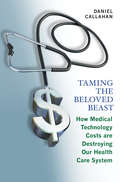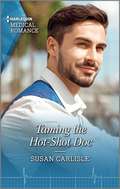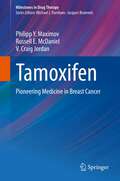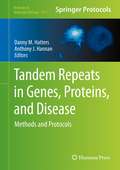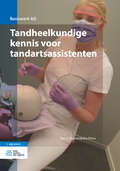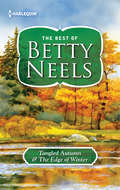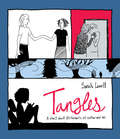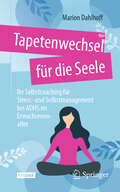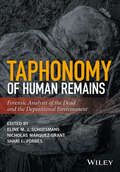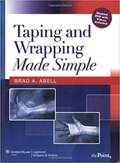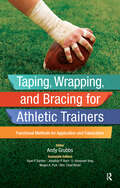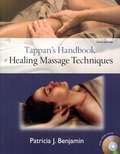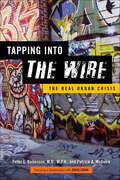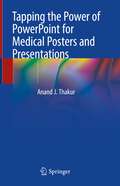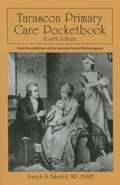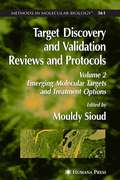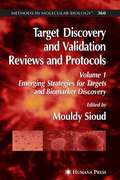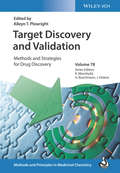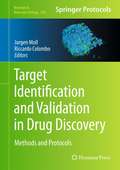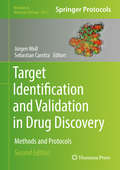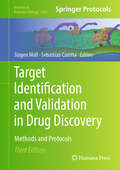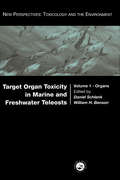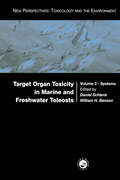- Table View
- List View
Taming The Black Dog: How To Beat Depression. A Practical Manual For Sufferers, Their Relatives And Their Colleagues
by Patrick EllvertonThis self help manual is for those for whom depression arises from the impact of exceptional circumstances such as childbirth and menopause, commercial and professional failure, accident, grief, divorce or debt as well as for those more permanent owners of the Black Dog.Contents: 1. Preface; 2. Your first step; 3. Medication; 4. Causes; 5. Manage your life; 6. Repulsing attacks; 7. Habits for repairing damage; 8. Utilising your subconscious computer; 9. Praying; 10. Vitality; 11. Sleeping; 12. Healthy eating; 13. Alcohol; 14. Fitness
Taming The Black Dog: How to Beat Depression - A Practical Manual for Sufferers, Their Relatives and Colleagues
by Patrick EllvertonThis self help manual is for those for whom depression arises from the impact of exceptional circumstances such as childbirth and menopause, commercial and professional failure, accident, grief, divorce or debt as well as for those more permanent owners of the Black Dog.Contents: 1. Preface; 2. Your first step; 3. Medication; 4. Causes; 5. Manage your life; 6. Repulsing attacks; 7. Habits for repairing damage; 8. Utilising your subconscious computer; 9. Praying; 10. Vitality; 11. Sleeping; 12. Healthy eating; 13. Alcohol; 14. Fitness
Taming the Beloved Beast: How Medical Technology Costs Are Destroying Our Health Care System
by Daniel CallahanWhy health care reform must tackle the escalating cost of medical technologyTechnological innovation is deeply woven into the fabric of American culture, and is no less a basic feature of American health care. Medical technology saves lives and relieves suffering, and is enormously popular with the public, profitable for doctors, and a source of great wealth for industry. Yet its costs are rising at a dangerously unsustainable rate. The control of technology costs poses a terrible ethical and policy dilemma. How can we deny people what they may need to live and flourish? Yet is it not also harmful to let rising costs strangle our health care system, eventually harming everyone?In Taming the Beloved Beast, esteemed medical ethicist Daniel Callahan confronts this dilemma head-on. He argues that we can't escape it by organizational changes alone. Nothing less than a fundamental transformation of our thinking about health care is needed to achieve lasting and economically sustainable reform. The technology bubble, he contends, is beginning to burst.Callahan weighs the ethical arguments for and against limiting the use of medical technologies, and he argues that reining in health care costs requires us to change entrenched values about progress and technological innovation. Taming the Beloved Beast shows that the cost crisis is as great as that of the uninsured. Only a government-regulated universal health care system can offer the hope of managing technology and making it affordable for all.
Taming the Hot-Shot Doc
by Susan CarlisleHe&’s lost everything…Dare he risk his heart?When renowned Chicago surgeon Matt Chapman agreed to testify against a notorious crime family, he lost his family, his fiancée and his career. Now he hopes to start again in an idyllic Mississippi town. But his efforts to keep to himself are threatened by his new boss, Dr. Shay Lunsford, who seems just as alone as he is. Dare Matt get closer to Shay and risk his heart again? &“Ms. Carlisle wrote a wonderful, flirty, and enjoyable romance that should not be missed. She provided a tale rich with emotions, sizzling chemistry, vivid scenic descriptions, and realistic characters…. I highly recommend Reunited with her Daredevil Doc to other readers.&”-Goodreads &“…Susan Carlisle was quick to nab my heart in The Single Dad&’s Holiday Wish. Great character interaction, several medical situations to heighten the drama and so many instances of pure holiday joy made this story a winner from start to finish! I highly recommend this book….&”-Goodreads
Tamoxifen: Pioneering Medicine in Breast Cancer
by Russell E. Mcdaniel Philipp Y. Maximov V. Craig JordanTamoxifen is a pioneering medicine for the treatment and prevention of breast cancer. It is the first drug targeted therapy in cancer to be successful. Tamoxifen targets the tumor estrogen receptor. The therapy is known to have saved the lives of millions of women over the past 40 years. This monograph, written by V. Craig Jordan - known as the "father of tamoxifen" - and his Tamoxifen Team at the Georgetown University Washington DC, illustrates the journey of this milestone in medicine. It includes a personal interview with V. Craig Jordan about his four decades of discovery in breast cancer research and treatment. V. Craig Jordan was there for the birth of tamoxifen as he is credited for reinventing a "failed morning after contraceptive" to become the "gold standard" for the treatment of breast cancer. He contributed to every aspect of tamoxifen application in therapeutics and all aspects of tamoxifen's pharmacology. He discovered the selective estrogen receptor modulators (SERMs) and explored the new biology of estrogen-induced apoptosis.
Tandem Repeats in Genes, Proteins, and Disease
by Danny M. Hatters Anthony J. HannanThe genomes of humans, as well as many other species, are interspersed with hundreds of thousands of tandem repeats of DNA sequences. Those tandem repeats located as codons within open reading frames encode amino acid runs, such as polyglutamine and polyalanine. Tandem repeats have not only been implicated in biological evolution, development and function but also in a large collection of human disorders. In Tandem Repeats in Genes, Proteins, and Disease: Methods and Protocols, expert researchers in the field detail many methods covering the analysis of tandem repeats in DNA, RNA and protein, in healthy and diseased states. This will include molecular genetics, molecular biology, biochemistry, proteomics, biophysics, cell biology, and molecular and cellular approaches to animal models of tandem repeat disorders. Written in the highly successful Methods in Molecular BiologyTM series format, chapters include introductions to their respective topics, lists of the necessary materials and reagents, step-by-step, readily reproducible laboratory protocols, and key tips on troubleshooting and avoiding known pitfalls. Authoratative and Practical, Tandem Repeats in Genes, Proteins, and Disease: Methods and Protocols aids scientists in continuing to study the unique methodological challenges that come from repetitive DNA and poly-amino acid sequences.
Tandheelkundige kennis voor tandartsassistenten (Basiswerk AG)
by Berry Duizendstra-PrinsHoe word je een goede tandartsassistent? De eisen die gesteld worden aan de moderne tandartsassistent worden steeds hoger. Van een tandartsassistent wordt verwacht dat ze proactief denkt en handelt. In de loop der jaren is het takenpakket uitgebreid met zelfstandige behandelingen. Het patiëntencontact wordt steeds intensiever. Een gedegen theoretische achtergrond wordt steeds belangrijker. Vakspecifieke onderwerpen die uitgebreid behandeld worden, zijn onder meer: preventie en parodontologie, restauratieve tandheelkunde, kindertandheelkunde en orthodontie, mondziekten, kaak- en aangezichtschirurgie, röntgenologie. Ook algemeen medische onderwerpen als anatomie en fysiologie van het hoofd-halsgebied, algemene ziekteleer en geneesmiddelenkennis maken deel uit van de aangeboden kennis. Het biedt hiermee een volledig overzicht van de belangrijkste tandheelkundige kennis voor de tandartsassistent. De tekst wordt ondersteund door tekeningen en full color afbeeldingen. Het boek wordt middels een website ondersteund met verdiepingsstof, vragen & opdrachten en kennistoetsen. Het is hiermee een onmisbaar basiswerk voor tandartsassistenten (in opleiding).
Tangled Autumn & The Edge of Winter: A Classic Doctor Romance Anthology
by Betty NeelsDiscover two classic romances from fan-favorite author Betty Neels Tangled Autumn Anxious to leave London and her cheating ex-fiancé behind, Sappha Devenish jumps at the chance of a job in Scotland. And if the scenery won’t take her mind off her heartbreak, then gorgeous but brooding Dutch doctor Rolf van Duyren will! But how will the object of her affection react when her ex makes an unexpected return…? The Edge of Winter Araminta Shaw is beginning to think her run ins with the guarded Dr. Crispin van Sibbelt are fated… And when he helps her care for a sick relative, she can’t help but fall into the attractive physician’s arms. Only, with marriage on the horizon, to Araminta’s dismay it seems that Crispin has a secret that could stand in the way of their happiness…
Tangles: A Story about Alzheimer's, My Mother, and Me
by Sarah LeavittWhat do you do when your outspoken, passionate, and quick-witted mother starts fading into a forgetful, fearful woman? In this powerful graphic memoir, Sarah Leavitt reveals how Alzheimer's disease transformed her mother Midge—and her family—forever.In spare black and white drawings and clear, candid prose, Sarah shares her family's journey through a harrowing range of emotions—shock, denial, hope, anger, frustration—all the while learning to cope, and managing to find moments of happiness. Midge, a Harvard-educated intellectual, struggles to comprehend the simplest words; Sarah's father Rob slowly adapts to his new role as full-time caretaker, but still finds time for word-play and poetry with his wife; Sarah and her sister Hannah argue, laugh, and grieve together as they join forces to help Midge get to sleep, rage about family friends who have disappeared, or collapse in tears at the end of a heartbreaking day.Tangles provides a window on the complexity of Alzheimer's disease, and ultimately opens a knot of moments, memories, and dreams to reveal a bond between a mother and a daughter that will never come apart.
Tapetenwechsel für die Seele: Ihr Selbstcoaching für Stress- und Selbstmanagement bei ADHS im Erwachsenenalter
by Marion DahlhoffAktivieren Sie jetzt Ihre ADHS Superpower! Freuen Sie sich dazu in diesem Buch auf einen klar strukturierten Selbstcoaching Prozess voller Erkenntnisse, Impulse und Humor. Dieser basiert auf einem wissenschaftlich fundierten Mix aus aktuellsten Forschungsergebnissen und Life Hacks von Fachleuten zu ADHS im Erwachsenenalter, Sport, Achtsamkeit und einem Selbst- und Stressmanagement das voll auf Ihre individuellen Bedürfnisse einzahlt. Durch zielgerichtete Selbstreflektion lernen Sie Ihre ADHS Symptomatik zunächst besser kennen und minimieren diese danach. Sie verbinden sich dazu mit Ihren wichtigsten Bedürfnissen in Ihrem Leben und entwickeln für sich motivierende Selbst- und Stressmanagement Strategien, die einfach in Ihrem Alltag umzusetzen sind. Dazu gestalten Sie sich Ihren ganz individuellen Lebenskompass für mehr Lebensqualität mit Ihrer ADHS und nähren so zukünftig Ihre Bedürfnisse regelmäßig in Ihren verschiedenen Lebensbereichen. So können Sie wunderbar Ihre Resilienz stärken, Ihre seelische Widerstandskraft in Ihrem Leben.
Taphonomy of Human Remains: Forensic Analysis of the Dead and the Depositional Environment
by Nicholas Márquez-Grant Eline M.J. Schotsmans Shari L. ForbesA truly interdisciplinary approach to this core subject within Forensic Science Combines essential theory with practical crime scene work Includes case studies Applicable to all time periods so has relevance for conventional archaeology, prehistory and anthropology Combines points of view from both established practitioners and young researchers to ensure relevance
Taping and Wrapping Made Simple
by Brad A. AbellTaping and Wrapping Made Simple is a basic yet comprehensive guide to taping and wrapping. Designed with the beginner or novice in mind, this text introduces the reader to basic anatomy, medical terminology, and general taping techniques. <p><p> The book begins by introducing essential supplies and terminology and then moves on to the basic foundation in taping and wrapping techniques as well as injury and wound care. The remainder of the book presents simple-to-follow procedures for the lower and upper body.
Taping, Wrapping, and Bracing for Athletic Trainers: Functional Methods for Application and Fabrication
by Andy GrubbsFor many years, sports medicine and health care practitioners have used taping and bracing for both the prevention and rehabilitation of injuries; consequently, specific protocols and techniques have evolved to ensure that the results are functional. With numerous methods available for orthopedic injuries, many texts go into all the applications in a given area or injury and leave readers wondering which one works best or is more useful. Taping, Wrapping, and Bracing for Athletic Trainers: Functional Methods for Application and Fabrication is a collection of some of the most commonly used and most functional taping, wrapping, and bracing techniques for orthopedic injuries.Andy Grubbs has designed this text to not only show the best method(s) for a given area but to add another method to each clinician’s bag of tricks. Taping, Wrapping, and Bracing for Athletic Trainers focuses on the most functional and useful methods in clinical settings and each application is performed in the proper manner to ensure functionality. With the step-by-step instructions, athletic trainers, coaches, and allied health care practitioners will gain comprehensive knowledge and practical skills to understand, reproduce and master the useful taping techniques. While this book offers material recommendations for each technique, it is important to understand that some taping techniques can be performed with a number of different types of taping materials.Features: Includes over 300 images Videos accompany each technique to further capture application and assist in technique mastery Covers basic anatomy and common injuries for each body region, as well as casting and splint making techniques Offers material recommendations for each bracing and taping technique Included with the text are online supplemental materials for faculty use in the classroom.Taping, Wrapping, and Bracing for Athletic Trainers: Functional Methods for Application and Fabrication will enhance any athletic training student or clinician’s current techniques along with providing recommended applications for taping and bracing for both prevention and rehabilitation of injuries.
Tappan's Handbook of Healing Massage Techniques Fifth Edition
by Patricia J. BenjaminThis pioneering book in massage therapy provides basic information on the art and science of effective healing massage techniques in quick-learn, easy-to-understand terms. Whether you're a licensed massage therapy practitioner, health related professional, or just interested in basic massage therapy techniques, this is the book for you! The authors carefully examine the foundations of healing massage, western massage techniques, contemporary massage including myofascial techniques, trigger points, lymphatic drainage massage, foot reflexology, Asian bodywork therapy and applications of massage. Practice Sequences that are step-by-step suggested example applications of the techniques are described in the book.
Tapping into The Wire: The Real Urban Crisis
by Peter L. Beilenson Patrick A. McGuireStory lines from The Wire challenge public perceptions about the deadly, real-world connections between drugs, crime, and poverty.Did Omar Little die of lead poisoning? Would a decriminalization strategy like the one in Hamsterdam end the War on Drugs? What will it take to save neglected kids like Wallace and Dukie? Tapping into 'The Wire' uses the acclaimed television series as a road map for exploring connections between inner-city poverty and drug-related violence. Past Baltimore City health commissioner Peter Beilenson teams up with former Baltimore Sun reporter Patrick A. McGuire to deliver a compelling, highly readable examination of urban policy and public health issues affecting cities across the nation. Each chapter recounts scenes from episodes of the HBO series, placing the characters' challenges into the broader context of public policy.A candid interview with the show’s co-creator David Simon reveals that one of the intentions of the series is to expose gross failures of public institutions, including criminal justice, education, labor, the news media, and city government. Even if readers haven’t seen the series, the book’s detailed summaries of scenes and characters brings them up to speed and engages them in both the story and the issues. With a firm grasp on the hard truths of real-world problems, Tapping into 'The Wire' helps undo misconceptions and encourage a dialogue of understanding.
Tapping the Power of PowerPoint for Medical Posters and Presentations
by Anand J. ThakurThis book talks about developing and improvising upon medical presentations by equipping readers with critical technical tips and tricks to use popular presentation programs like PowerPoint or Keynote effectively. The book details numerous remedial measures for qualitative improvement of average medical presentations. It has three sections: first covers the general aspects of preparing a presentation; the second provides practical details and refinements of preparing a medical presentation; the last section deals with niceties of podium and webinar presentations. The chapters cover many serious mistakes and remedial measures to improve average medical presentations, such as a description of purposeful use of colors in a slide, a brief discourse on technicalities of appropriate clinical image formats for projection ensues; the use of drawing and photo-editing programs to inject excellence in the contents of a medical presentation to help it stand out in the crowd, details on the importance of lexical correctness- typography, line spacing and alignment to enhance the impact of the presented text and many more. Several short videos support and actively promote the viewpoints discussed in the text. This book elaborates on the exquisite art of creating remarkable medical presentations for a specialized audience. This book is a must-have for all healthcare professionals of all specialties and grades who make podium presentations in a medical conference webinar or submit posters for display.
Tarascon Primary Care Pocketbook (Fourth Edition)
by Joseph S. EsherickThe Tarascon Primary Care Pocketbook, Fourth Edition is intended to be a quick reference guide for clinicians and students practicing primary care medicine. I have attempted to compile the core information about most primary care topics in a concise format.
Target Discovery and Validation Reviews and Protocols: Emerging Molecular Targets and Treatment Options, Volume 2
by Mouldy SioudTarget Discovery and Validation Reviews and Protocols, Volumes 1 and 2 review the most progressive and current methods for drug target discovery and validation. These volumes explore how recent improvement in understanding the molecular mechanisms of human pathology is impacting drug target discovery in the laboratory and in real therapeutics, specifically for cancers and autoimmune disorders.<P><P> Volume 1 focuses on novel and innovative techniques, and presents the most up-to-date protocols available for maximizing the likelihood of achieving target-selective inhibition in vivo while minimizing side effects. The profound impact of genomics, proteomics and bioinformatics on target discovery is explored, and specific attention is given to the role of transgenic and knockout animals in functional genomics and target validation. Cancer researchers will find tremendous value in the molecular classification of breast cancers and the review of protocols for tumor antigens and cancer vaccines. The methods and protocols collected here, all reviewed by leading scientists and clinicians, present the practical details necessary for translating the enormous discovery potential of the genome into real therapeutic products.<P> Volume 2 collects all the practical details required for efficient translation of discovered targets into real pharmaceutical drugs. Specific targets in cancers and autoimmunity are described and the potential of using siRNAs, antisense oligonucleotides and RNA aptamers in patients is reviewed. This volume explores the tremendous impact of the application of genotyping and gene expression profiling on the future of healthcare, and presents cutting-edge protocols to aid in bringing agents against specific targets closer to application in the clinic.<P> Collectively, these volumes provide a thorough review of the most cutting-edge methods available for each step in drug target identification, validation, and clinical application. For researchers, an understanding of available methods aids in the creation of innovative experiments in the laboratory, and the successful translation of target discovery to real therapeutics.
Target Discovery and Validation Reviews and Protocols: Emerging Strategies for Targets and Biomarker Discovery, Volume 1
by Mouldy SioudTarget Discovery and Validation Reviews and Protocols, Volumes 1 and 2 review the most progressive and current methods for drug target discovery and validation. These volumes explore how recent improvement in understanding the molecular mechanisms of human pathology is impacting drug target discovery in the laboratory and in real therapeutics, specifically for cancers and autoimmune disorders.<P><P> Volume 1 focuses on novel and innovative techniques, and presents the most up-to-date protocols available for maximizing the likelihood of achieving target-selective inhibition in vivo while minimizing side effects. The profound impact of genomics, proteomics and bioinformatics on target discovery is explored, and specific attention is given to the role of transgenic and knockout animals in functional genomics and target validation. Cancer researchers will find tremendous value in the molecular classification of breast cancers and the review of protocols for tumor antigens and cancer vaccines. The methods and protocols collected here, all reviewed by leading scientists and clinicians, present the practical details necessary for translating the enormous discovery potential of the genome into real therapeutic products.<P> Volume 2 collects all the practical details required for efficient translation of discovered targets into real pharmaceutical drugs. Specific targets in cancers and autoimmunity are described and the potential of using siRNAs, antisense oligonucleotides and RNA aptamers in patients is reviewed. This volume explores the tremendous impact of the application of genotyping and gene expression profiling on the future of healthcare, and presents cutting-edge protocols to aid in bringing agents against specific targets closer to application in the clinic.<P> Collectively, these volumes provide a thorough review of the most cutting-edge methods available for each step in drug target identification, validation, and clinical application. For researchers, an understanding of available methods aids in the creation of innovative experiments in the laboratory, and the successful translation of target discovery to real therapeutics.
Target Discovery and Validation: Methods and Strategies for Drug Discovery (Methods and Principles in Medicinal Chemistry)
by Raimund Mannhold Jörg Holenz Helmut BuschmannThe modern drug developers? guide for making informed choices among the diverse target identification methods Target Discovery and Validation: Methods and Strategies for Drug Discovery offers a hands-on review of the modern technologies for drug target identification and validation. With contributions from noted industry and academic experts, the book addresses the most recent chemical, biological, and computational methods. Additionally, the book highlights techologies that are applicable to ?difficult? targets and drugs directed at multiple targets, including chemoproteomics, activity-based protein profiling, pathway mapping, genome-wide association studies, and array-based profiling. Throughout, the authors highlight a range of diverse approaches, and target validation studies reveal how these methods can support academic and drug discovery scientists in their target discovery and validation research. This resource: -Offers a guide to identifying and validating targets, a key enabling technology without which no new drug development is possible -Presents the information needed for choosing the appropriate assay method from the ever-growing range of available options -Provides practical examples from recent drug development projects, e. g. in kinase inhibitor profiling Written for medicinal chemists, pharmaceutical professionals, biochemists, biotechnology professionals, and pharmaceutical chemists, Target Discovery and Validation explores the current methods for the identification and validation of drug targets in one comrpehensive volume. It also includes numerous practical examples.
Target Identification and Validation in Drug Discovery
by Jurgen Moll Riccardo ColomboThe major reason for the elevated costs of drug development in the pharmaceutical industry is the high attrition rate. In Target Identification and Validation in Drug Discovery: Methods and Protocols, expert researchers in the field detail many of the methods which are now commonly used to identify and validate new target. These include methods and approaches covering biochemical, cell based, in vivo models and translational methods. Chapters also include selected case reports that demonstrate the integration of these technologies to real life experiences and to demonstrate the multiple use of more than one technology to increase knowledge on a specific target. These Written in the highly successful Methods in Molecular BiologyTM series format, the chapters include the kind of detailed description and implementation advice that is crucial for getting optimal results in the laboratory. Thorough and intuitive, Target Identification and Validation in Drug Discovery: Methods and Protocols contains a comprehensive list of essential methods and clear protocols to follow.
Target Identification and Validation in Drug Discovery: Methods And Protocols (Methods In Molecular Biology Series #1953)
by Jürgen Moll Sebastian CarottaThis second edition book explores breakthrough technologies in the field of drug target identification and validation. The volume emphasizes particularly revolutionary technologies, such as CRISPR-related screening, “big data,” and in silico approaches, as well as in vivo applications of CRISPR and best uses of animal models in drug development. Written for the highly successful Methods in Molecular Biology series, chapters include introductions to their respective topics, lists of the necessary materials and reagents, step-by-step, readily reproducible laboratory protocols, and tips on troubleshooting and avoiding known pitfalls. <P><P> Fully updated and authoritative, Target Identification and Validation in Drug Discovery: Methods and Protocols, Second Edition is an ideal guide for molecular and cellular biologists, pharmacologists, pathologists, bioinformaticians, clinical researchers, or investigators, as well as experts in other fields that need a quick overview of these state-of-the-art technologies.
Target Identification and Validation in Drug Discovery: Methods and Protocols (Methods in Molecular Biology #2905)
by Jürgen Moll Sebastian CarottaThis third edition book explores breakthrough techniques in the field of drug target identification and validation. With technologies and methodologies ranging from target identification to the analysis of clinical samples, as well as newer areas like artificial intelligence and machine learning applications, the book will aid decision-makers in drug development by offering a succinct overview of the available technologies for portfolio management. Written for the highly successful Methods in Molecular Biology series, chapters include introductions to their respective topics, lists of the necessary materials and reagents, step-by-step and readily reproducible laboratory protocols, and tips on troubleshooting and avoiding known pitfalls. Authoritative and up-to-date, Target Identification and Validation in Drug Discovery: Methods and Protocols, Third Edition will help a diverse audience of scientists find valuable insights to address their drug development inquiries.
Target Organ Toxicity in Marine and Freshwater Teleosts: Organs (New Perspectives: Toxicology and the Environment)
by Daniel Schlenk, William H. BensonAddressing the numerous gaps in current information, Target Organ Toxicology in Marine and Freshwater Teleosts is an essential resource for researchers and professionals in aquatic toxicology and environmental risk assessment. All the chapters are written by researchers who are internationally recognised for their work in mechanistic aspects of aquatic toxicology. Each chapter focuses on a specific target organ or physiological system and describes how various agents disrupt the normal physiological system and processes. This volume is devoted to specific organs with coverage of the gill, kidney, skin, liver and gut. The companion volume, Systems, provides coverage of toxic effects in the central nervous, immune, neurobehavioural and reproductive systems as well as describing general mechanisms of toxicity.
Target Organ Toxicity in Marine and Freshwater Teleosts: Systems (New Perspectives: Toxicology and the Environment)
by William H. Benson Daniel SchlenkAddressing the numerous gaps in current information, Target Organ Toxicology in Marine and Freshwater Teleosts is an essential resource for researchers and professionals in aquatic toxicology and environmental risk assessment.All the chapters are written by researchers who are internationally recognised for their work in mechanistic aspects of

